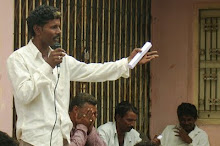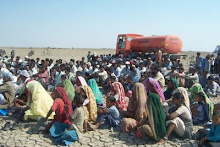Aljazeera: Asia: Saturday, December 16, 2017.
Rann of
Kutch, India - The Agariyas tribe in Gujarat's Rann of Kutch desert near the
Arabian Sea is excited yet doubtful as to whether elections in one of India's
most industrialised states will change their fortunes.
Marked by
mass illiteracy, lack of education and health facilities, and political
underrepresentation, the community lives on the margins of the Gujarati
society.
For eight
months between mid-November and August, Agariya people live in the desert,
working under extreme weather conditions, helping to produce about 76 percent
of India's salt.
They have
been salt producers for generations, and consist today of around 10,000
families, comprising 45,000 people, mostly located in the Rann of Kutch region.
Indian Prime
Minister Narendra Modi has projected Gujarat as a model of development worth
emulating at the national level. He ran the state government for nearly 13
years until 2014.
But the
model, which has been said to work on the pillars of electricity, water and
sanitation for all, has provided none of these for the Agariyas.
Few signs
of development
Even though
long electric lines cover the Little Rann, the Agariya homes are still without
electricity, with few visible signs of the development that the ruling
Bharatiya Janata Party (BJP) claims.
"In
Maliya [in Morbi district] itself, there is no waste disposal system, no proper
school, no electricity most of the time," said Ramesh Katesiya, a social
worker from Anandi, a local NGO working among the community.
"There
was a bus stand that got destroyed in the 2001 earthquake in Bhuj. They still
have not reconstructed that," said Katesiya, referring to the village
closest to where the Agariyas of Morbi district live.
"He has
never even been here to see which people actually live and contribute to
Gujarat's apparent progress," he added, referring to Modi, who has
extensively campaigned during the state elections.
Many Agariyas
with whom Al Jazeera spoke expressed their anger against the ruling BJP party,
which has been in power for most of the last 21 years.
Overlooked by
the political class for decades, the Agariyas now show little enthusiasm in the
election process. This year, an election campaign held by the District
Collector in Surendranagar district has raised awareness of the importance of
political participation.
There are no
hospitals within close reach of the Agariyas, or routine check-ups by state
officials to ensure their health.
In Morbi, the
nearest government hospitals are 20 to 100 kilometres away from the salt
farmers. There are no roads or public transport that lead inside the Rann,
leaving the Agariyas stranded in times of medical emergency.
"The
Agariyas live for eight months a year without electricity, basic shelter and
any medicine," Katesiya said. "Because of their laborious work, they
are prone to high fevers, tuberculosis, dehydration and severe skin burns
during the summer months. In the last election, the BJP won all eight seats in
this region, but still, they [the government] did nothing to help the people
here. Because of that, the opposition [Congress party] has begun to gain a
stronghold in these parts."
Makeshift
camps
It is
December, and the salt season has just begun. The sand is being pumped for
brine by machines that run on diesel. The brine will then be distributed into
channels, where it will cook for three months to become salt.
Because of
the lack of roads and public transport into the desert, the Agariyas are forced
to live in makeshift camps in the desert for eight months of the year.
Savita
Dhirubhai Koli, like other members of her community, works on land of about
four hectares for 12 to 14 hours a day.
During the
rains, the desert sand turns into a heavy marsh, making walking or riding a
motorcycle on it difficult.
"It has
been a month since we arrived," said Koli, who lives in a hut made from
jute bags and tarpaulin in Gulbadi, a stretch of desert in the Morbi district.
"I just finished building the house, but now that it has rained, it is
very wet, and water has already settled inside."
During the
rains, water seeps in easily, and a strong wind destroys many Agariya homes.
In winters,
temperatures are as low as 2 degrees, but the Agariyas, along with their
children, continue to live in these desert huts that offer no protection from
extreme weather conditions.
"We have
nothing to keep warm," said Raju, a salt farmer from the Agariya community
from the Morbi district, around 10 kilometres from the Arabian Sea. "I
have three small children. They always get sick. But what can I do?"
Salt farmers
mostly work as labourers employed by middlemen or large salt firms. They make
Rs 25-35 ($0.40-$0.50) for each tonne of salt they produce.
Before the
season begins, the Agariyas take a loan from an informal credit system called
"dhiraan", which they pay back at the time of harvest.
At the end of
eight months, they produce around 3,000 tonnes - for which, after their loan
has been deducted, they make only around Rs 40,000 ($600).
"Players
like Dev Salt drain the backwaters with their large machines," said Marut,
an activist with the Agariya Rashtriya Heet Manch (AHRM). "It is a threat
to the smaller farms like the ones in Haripar."
State
support 'absent'
This July,
severe floods hit Gujarat - and in Maliya alone, 30,000 tonnes of salt was
washed away. The erratic rains have also delayed the production season, causing
the Agariyas to worry that they may have to work extra days in the coming
winter months.
While
Agariyas were landowners in the past, the declaration of the Little Rann as
Wild Ass Sanctuary in 1978 established that the government would own all the
land.
"This
has reduced previously land-owning Agariya families to positions of
tenancy," said Pankti Jog, an activist with the AHRM. "But even then,
state support or assistance on this land or the process is absent."
In Haripar in
Morbi district, closer to the highway, mobility is easier than in other parts
of the Rann. Of the around 1,500 Agariyas who work here, some have solar panels
and can go back to nearby villages in case of extreme weather.
But even
here, hospitals are at least 20 kilometres away, and there are no schools
anywhere in sight.
"The
district collector told us if we collect children, he will help us make a
temporary school," said Sunita, an Agariya who lives in Haripar. "But
even if we do, where will they make the school? Who will come to teach here in
the middle of the desert?"
The Agariya
literacy rate is close to zero, leaving no opportunities for social mobility
for the next generation.
"Our
children begin working when they are 10 years old," said Ramesh, Sunita's
husband. "If we don't produce enough, the buyers will go to someone else,
so we have to keep him happy."
Areas of the
Little Rann are also called Survey Zone Zero, as no census has been conducted
here since Indian independence from the British colonial rulers in 1947.
"The
absence of a census, or proper data on the Agariyas, makes it hard to know what
they go through and what they need," Jog said. "Including the
Agariyas is a matter of state governance, which has not been done until
now."
Maintaining
hope
In Morbi
district, there is hope among the Agariyas that a new government, unlike the
present BJP, may listen to their concerns.
"We will
tell them we need roads, so we don't have to live out here in the cold, and
education for our children," Ramesh said. "If the (BJP) government
can build tall, expensive buildings in the city, why can't they spare some
money for our roads and homes?"
While one
official in Haripar has promised to send a car to bring Agariyas to the polling
station, in Gulbadi and the Rann surrounding Surendrangar district and faraway
settlements, no such arrangements have been made. Moreover, the declaration of
the Little Rann as a sanctuary prohibits mobile voting booths to enter it,
making it impossible for Agariyas far away to participate.
"The
ones who live 30 to 50 kilometres away will try to come," Jog said.
"But those 100 kilometres or so away from their villages, how will they go
to vote?"
On December
9, some Agariyas will come to vote in the first phase of the elections,
travelling by vehicle from the nearest possible point, and others - the more
resilient - will walk.
"If I
can work for 14 hours in the sun, I can walk 15 kilometres to cast a
vote," said Kumar, who lives in Gulbadi. "It is possible that nothing
changes with any new government. But we have to make them notice us; maybe that
will be a start."


















.jpg)
.jpg)
.jpg)
.jpg)













No comments:
Post a Comment